Abstract
Instances when T cell activation via the T cell receptor/CD3 complex is suppressed by anti-CD4 Abs are generally attributed either to the topological separation of CD4-p56lck from CD3, or their improper apposition. Photobleaching fluorescence resonance energy transfer measurements permitted direct analysis of these alternatives on human peripheral blood lymphocytes. Distinction between changes of relative antigen densities or positioning was made possible by simultaneously recording donor and acceptor fluorescence in the energy transfer experiment performed on homogeneous populations of flow-sorted cells. We show here that CD4 stays in the molecular vicinity of CD3, while anti-CD3 stimulation is suppressed by anti-CD4 or cross-linked HIV gp120. Our data suggest that cross-linking of CD4 through particular epitopes is capable of inhibiting activation driven by Abs binding to specific sites on CD3 without major topological sequestration of the Ags, in such a way that additional positive signals will also be affected. Thus, these and other related cases of negative signaling via CD4 may be interpreted in terms of functional uncoupling rather than a wide physical separation of CD4 from the T cell receptor-CD3 complex.
Full text
PDF
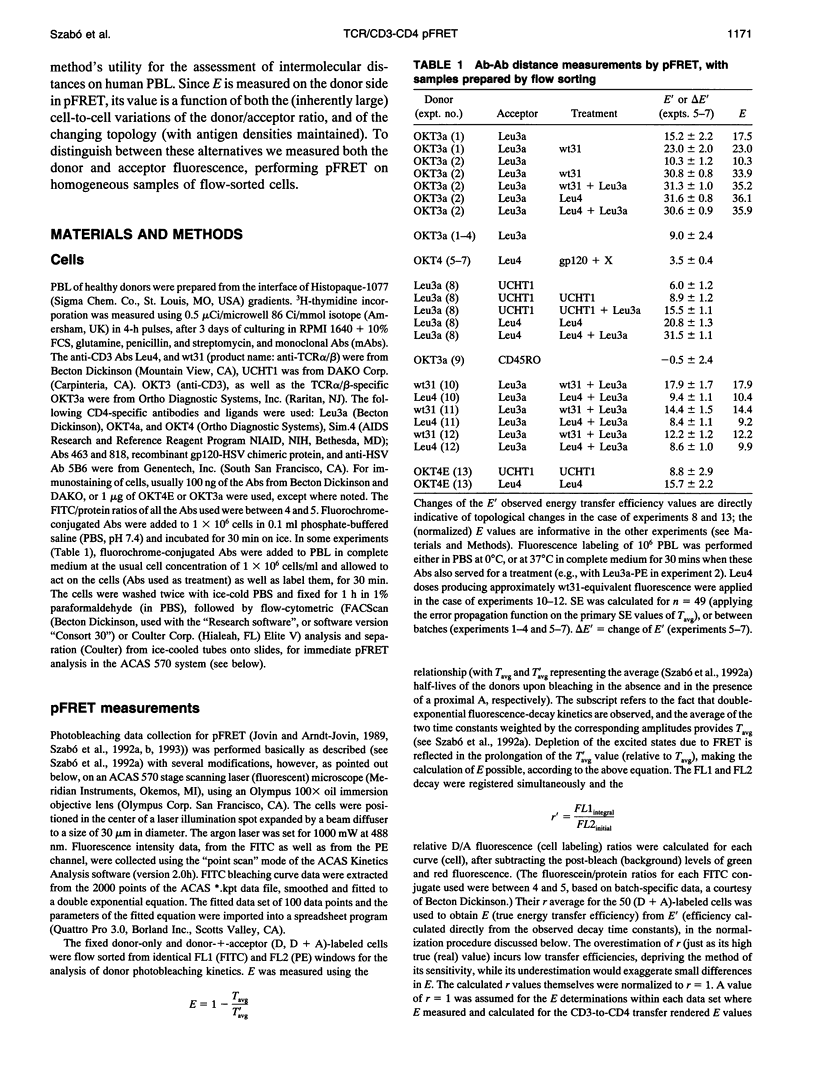
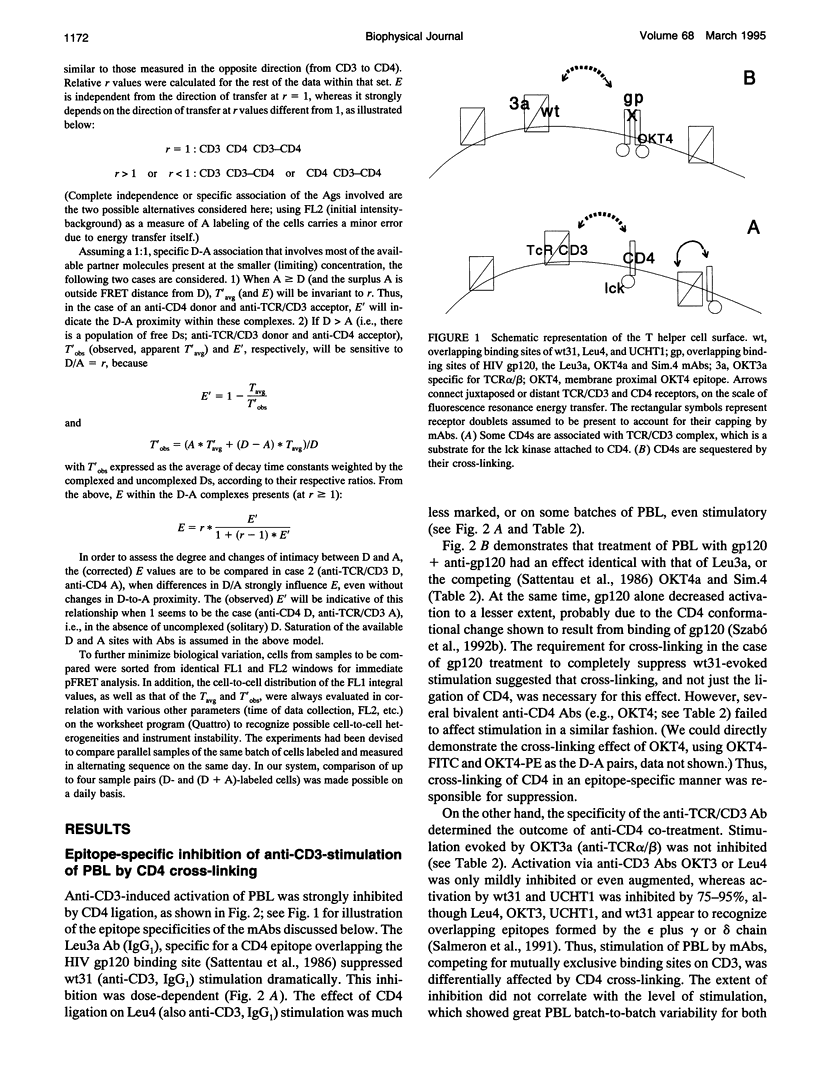
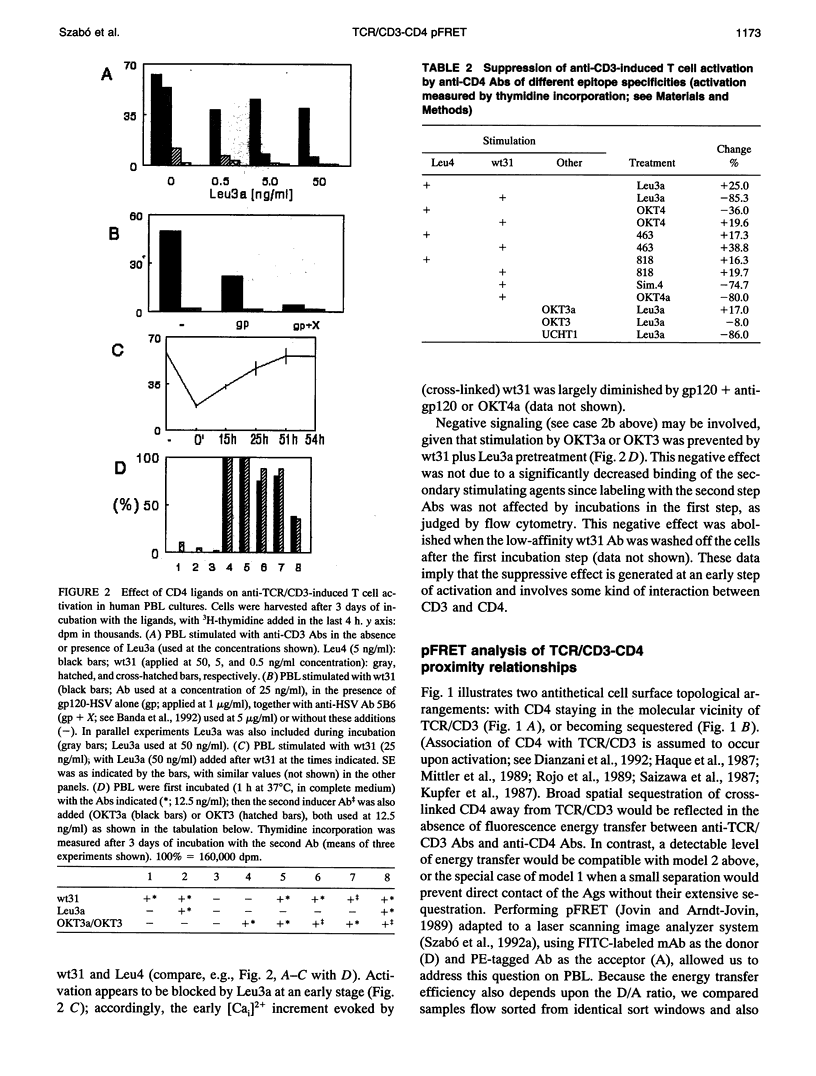
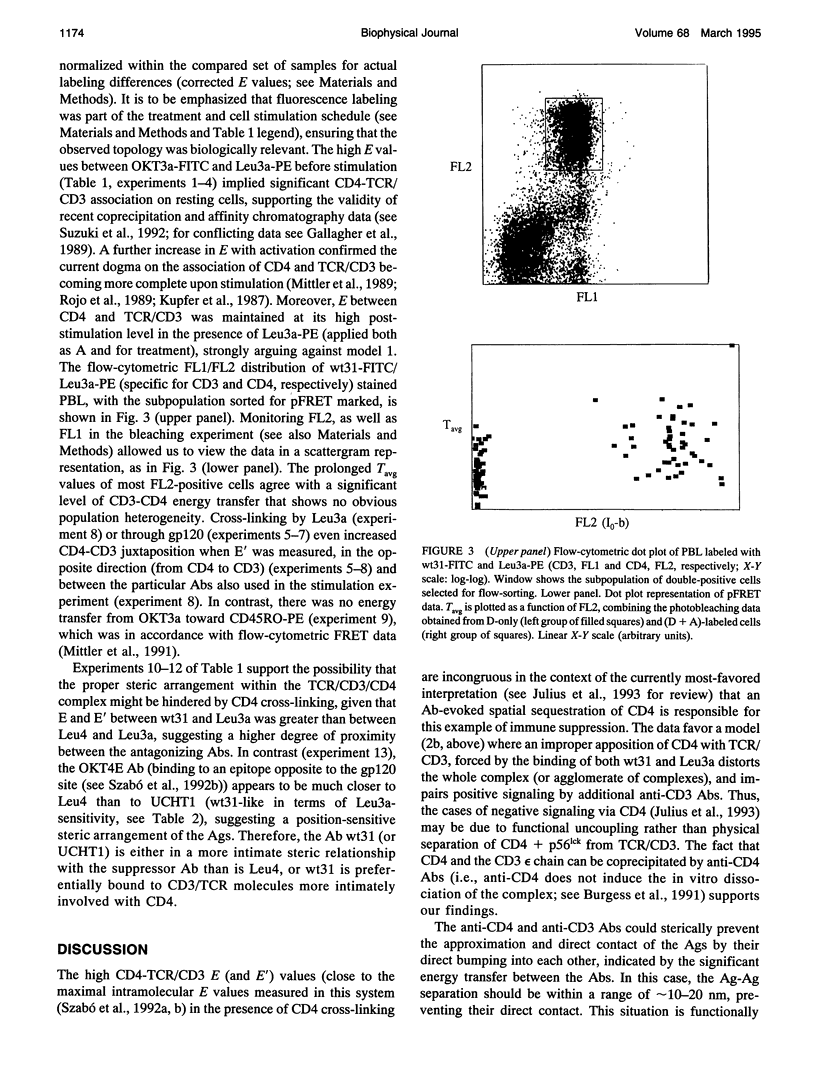
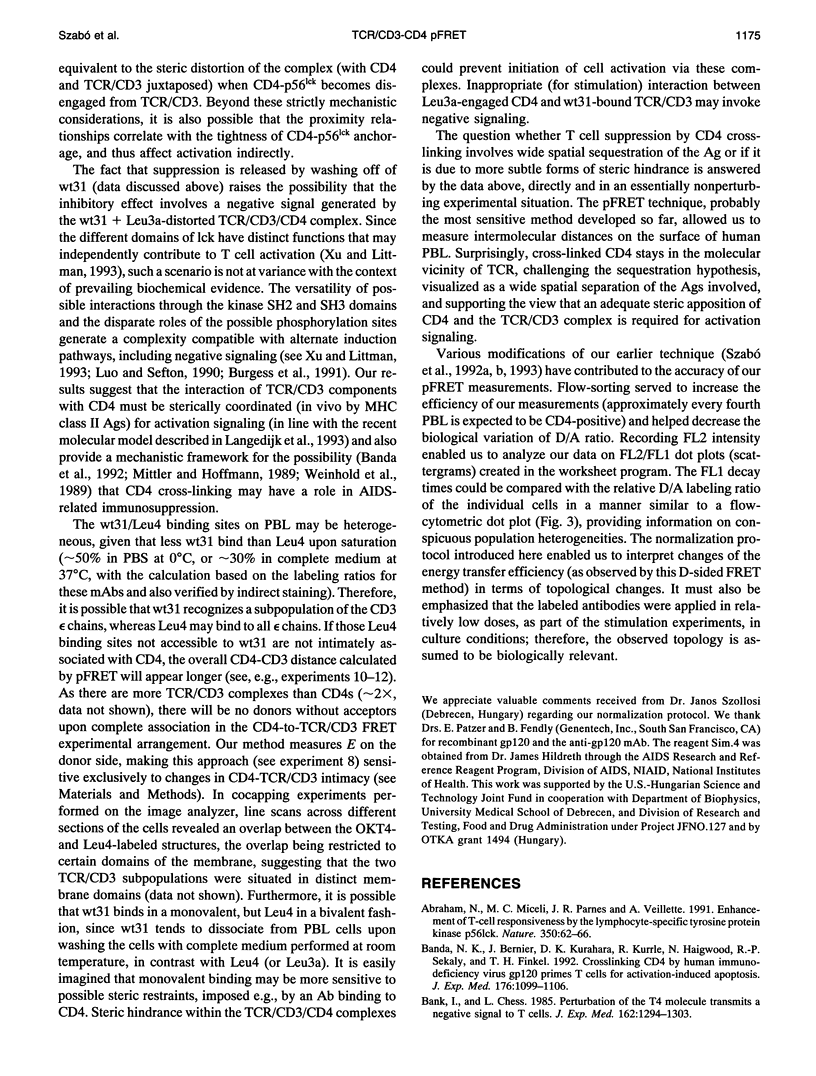

Selected References
These references are in PubMed. This may not be the complete list of references from this article.
- Abraham N., Miceli M. C., Parnes J. R., Veillette A. Enhancement of T-cell responsiveness by the lymphocyte-specific tyrosine protein kinase p56lck. Nature. 1991 Mar 7;350(6313):62–66. doi: 10.1038/350062a0. [DOI] [PubMed] [Google Scholar]
- Banda N. K., Bernier J., Kurahara D. K., Kurrle R., Haigwood N., Sekaly R. P., Finkel T. H. Crosslinking CD4 by human immunodeficiency virus gp120 primes T cells for activation-induced apoptosis. J Exp Med. 1992 Oct 1;176(4):1099–1106. doi: 10.1084/jem.176.4.1099. [DOI] [PMC free article] [PubMed] [Google Scholar]
- Bank I., Chess L. Perturbation of the T4 molecule transmits a negative signal to T cells. J Exp Med. 1985 Oct 1;162(4):1294–1303. doi: 10.1084/jem.162.4.1294. [DOI] [PMC free article] [PubMed] [Google Scholar]
- Burgess K. E., Odysseos A. D., Zalvan C., Druker B. J., Anderson P., Schlossman S. F., Rudd C. E. Biochemical identification of a direct physical interaction between the CD4:p56lck and Ti(TcR)/CD3 complexes. Eur J Immunol. 1991 Jul;21(7):1663–1668. doi: 10.1002/eji.1830210712. [DOI] [PubMed] [Google Scholar]
- Collins T. L., Uniyal S., Shin J., Strominger J. L., Mittler R. S., Burakoff S. J. p56lck association with CD4 is required for the interaction between CD4 and the TCR/CD3 complex and for optimal antigen stimulation. J Immunol. 1992 Apr 1;148(7):2159–2162. [PubMed] [Google Scholar]
- Dianzani U., Shaw A., al-Ramadi B. K., Kubo R. T., Janeway C. A., Jr Physical association of CD4 with the T cell receptor. J Immunol. 1992 Feb 1;148(3):678–688. [PubMed] [Google Scholar]
- Gallagher P. F., Fazekas de St Groth B., Miller J. F. CD4 and CD8 molecules can physically associate with the same T-cell receptor. Proc Natl Acad Sci U S A. 1989 Dec;86(24):10044–10048. doi: 10.1073/pnas.86.24.10044. [DOI] [PMC free article] [PubMed] [Google Scholar]
- Glaichenhaus N., Shastri N., Littman D. R., Turner J. M. Requirement for association of p56lck with CD4 in antigen-specific signal transduction in T cells. Cell. 1991 Feb 8;64(3):511–520. doi: 10.1016/0092-8674(91)90235-q. [DOI] [PubMed] [Google Scholar]
- Haque S., Saizawa K., Rojo J., Janeway C. A., Jr The influence of valence on the functional activities of monoclonal anti-L3T4 antibodies. Discrimination of signaling from other effects. J Immunol. 1987 Nov 15;139(10):3207–3212. [PubMed] [Google Scholar]
- Haughn L., Gratton S., Caron L., Sékaly R. P., Veillette A., Julius M. Association of tyrosine kinase p56lck with CD4 inhibits the induction of growth through the alpha beta T-cell receptor. Nature. 1992 Jul 23;358(6384):328–331. doi: 10.1038/358328a0. [DOI] [PubMed] [Google Scholar]
- Janeway C. A., Jr The role of CD4 in T-cell activation: accessory molecule or co-receptor? Immunol Today. 1989 Jul;10(7):234–238. doi: 10.1016/0167-5699(89)90260-0. [DOI] [PubMed] [Google Scholar]
- Julius M., Maroun C. R., Haughn L. Distinct roles for CD4 and CD8 as co-receptors in antigen receptor signalling. Immunol Today. 1993 Apr;14(4):177–183. doi: 10.1016/0167-5699(93)90282-p. [DOI] [PubMed] [Google Scholar]
- Kupfer A., Singer S. J., Janeway C. A., Jr, Swain S. L. Coclustering of CD4 (L3T4) molecule with the T-cell receptor is induced by specific direct interaction of helper T cells and antigen-presenting cells. Proc Natl Acad Sci U S A. 1987 Aug;84(16):5888–5892. doi: 10.1073/pnas.84.16.5888. [DOI] [PMC free article] [PubMed] [Google Scholar]
- Langedijk J. P., Puijk W. C., van Hoorn W. P., Meloen R. H. Location of CD4 dimerization site explains critical role of CDR3-like region in HIV-1 infection and T-cell activation and implies a model for complex of coreceptor-MHC. J Biol Chem. 1993 Aug 15;268(23):16875–16878. [PubMed] [Google Scholar]
- Luo K. X., Sefton B. M. Cross-linking of T-cell surface molecules CD4 and CD8 stimulates phosphorylation of the lck tyrosine protein kinase at the autophosphorylation site. Mol Cell Biol. 1990 Oct;10(10):5305–5313. doi: 10.1128/mcb.10.10.5305. [DOI] [PMC free article] [PubMed] [Google Scholar]
- McDonnell J. M., Blank K. J., Rao P. E., Jameson B. A. Direct involvement of the CDR3-like domain of CD4 in T helper cell activation. J Immunol. 1992 Sep 1;149(5):1626–1630. [PubMed] [Google Scholar]
- Mittler R. S., Goldman S. J., Spitalny G. L., Burakoff S. J. T-cell receptor-CD4 physical association in a murine T-cell hybridoma: induction by antigen receptor ligation. Proc Natl Acad Sci U S A. 1989 Nov;86(21):8531–8535. doi: 10.1073/pnas.86.21.8531. [DOI] [PMC free article] [PubMed] [Google Scholar]
- Mittler R. S., Hoffmann M. K. Synergism between HIV gp120 and gp120-specific antibody in blocking human T cell activation. Science. 1989 Sep 22;245(4924):1380–1382. doi: 10.1126/science.2571187. [DOI] [PubMed] [Google Scholar]
- Mittler R. S., Rankin B. M., Kiener P. A. Physical associations between CD45 and CD4 or CD8 occur as late activation events in antigen receptor-stimulated human T cells. J Immunol. 1991 Nov 15;147(10):3434–3440. [PubMed] [Google Scholar]
- Nel A. E., Pollack S., Landreth G., Ledbetter J. A., Hultin L., Williams K., Katz R., Akerley B. CD-3-mediated activation of MAP-2 kinase can be modified by ligation of the CD4 receptor. Evidence for tyrosine phosphorylation during activation of this kinase. J Immunol. 1990 Aug 1;145(3):971–979. [PubMed] [Google Scholar]
- Newell M. K., Haughn L. J., Maroun C. R., Julius M. H. Death of mature T cells by separate ligation of CD4 and the T-cell receptor for antigen. Nature. 1990 Sep 20;347(6290):286–289. doi: 10.1038/347286a0. [DOI] [PubMed] [Google Scholar]
- Rojo J. M., Janeway C. A., Jr The biologic activity of anti-T cell receptor V region monoclonal antibodies is determined by the epitope recognized. J Immunol. 1988 Feb 15;140(4):1081–1088. [PubMed] [Google Scholar]
- Rojo J. M., Saizawa K., Janeway C. A., Jr Physical association of CD4 and the T-cell receptor can be induced by anti-T-cell receptor antibodies. Proc Natl Acad Sci U S A. 1989 May;86(9):3311–3315. doi: 10.1073/pnas.86.9.3311. [DOI] [PMC free article] [PubMed] [Google Scholar]
- Rudd C. E., Trevillyan J. M., Dasgupta J. D., Wong L. L., Schlossman S. F. The CD4 receptor is complexed in detergent lysates to a protein-tyrosine kinase (pp58) from human T lymphocytes. Proc Natl Acad Sci U S A. 1988 Jul;85(14):5190–5194. doi: 10.1073/pnas.85.14.5190. [DOI] [PMC free article] [PubMed] [Google Scholar]
- Saizawa K., Rojo J., Janeway C. A., Jr Evidence for a physical association of CD4 and the CD3:alpha:beta T-cell receptor. Nature. 1987 Jul 16;328(6127):260–263. doi: 10.1038/328260a0. [DOI] [PubMed] [Google Scholar]
- Salmerón A., Sánchez-Madrid F., Ursa M. A., Fresno M., Alarcón B. A conformational epitope expressed upon association of CD3-epsilon with either CD3-delta or CD3-gamma is the main target for recognition by anti-CD3 monoclonal antibodies. J Immunol. 1991 Nov 1;147(9):3047–3052. [PubMed] [Google Scholar]
- Sattentau Q. J., Dalgleish A. G., Weiss R. A., Beverley P. C. Epitopes of the CD4 antigen and HIV infection. Science. 1986 Nov 28;234(4780):1120–1123. doi: 10.1126/science.2430333. [DOI] [PubMed] [Google Scholar]
- Straus D. B., Weiss A. Genetic evidence for the involvement of the lck tyrosine kinase in signal transduction through the T cell antigen receptor. Cell. 1992 Aug 21;70(4):585–593. doi: 10.1016/0092-8674(92)90428-f. [DOI] [PubMed] [Google Scholar]
- Suzuki S., Kupsch J., Eichmann K., Saizawa M. K. Biochemical evidence of the physical association of the majority of CD3 delta chains with the accessory/co-receptor molecules CD4 and CD8 on nonactivated T lymphocytes. Eur J Immunol. 1992 Oct;22(10):2475–2479. doi: 10.1002/eji.1830221002. [DOI] [PubMed] [Google Scholar]
- Szabà G., Jr, Pine P. S., Weaver J. L., Kasari M., Aszalos A. Epitope mapping by photobleaching fluorescence resonance energy transfer measurements using a laser scanning microscope system. Biophys J. 1992 Mar;61(3):661–670. doi: 10.1016/S0006-3495(92)81871-4. [DOI] [PMC free article] [PubMed] [Google Scholar]
- Szabò G., Jr, Pine P. S., Weaver J. L., Rao P. E., Aszalos A. CD4 changes conformation upon ligand binding. J Immunol. 1992 Dec 1;149(11):3596–3604. [PubMed] [Google Scholar]
- Szabó G., Jr, Weaver J. L., Pine P. S., Aszalos A. Specific disengagement of cell-bound anti-LAM-1 (anti-L-selectin) antibodies by aurintricarboxylic acid. Mol Immunol. 1993 Dec;30(18):1689–1694. doi: 10.1016/0161-5890(93)90444-g. [DOI] [PubMed] [Google Scholar]
- Veillette A., Bookman M. A., Horak E. M., Bolen J. B. The CD4 and CD8 T cell surface antigens are associated with the internal membrane tyrosine-protein kinase p56lck. Cell. 1988 Oct 21;55(2):301–308. doi: 10.1016/0092-8674(88)90053-0. [DOI] [PubMed] [Google Scholar]
- Weinhold K. J., Lyerly H. K., Stanley S. D., Austin A. A., Matthews T. J., Bolognesi D. P. HIV-1 GP120-mediated immune suppression and lymphocyte destruction in the absence of viral infection. J Immunol. 1989 May 1;142(9):3091–3097. [PubMed] [Google Scholar]
- Xu H., Littman D. R. A kinase-independent function of Lck in potentiating antigen-specific T cell activation. Cell. 1993 Aug 27;74(4):633–643. doi: 10.1016/0092-8674(93)90511-n. [DOI] [PubMed] [Google Scholar]


